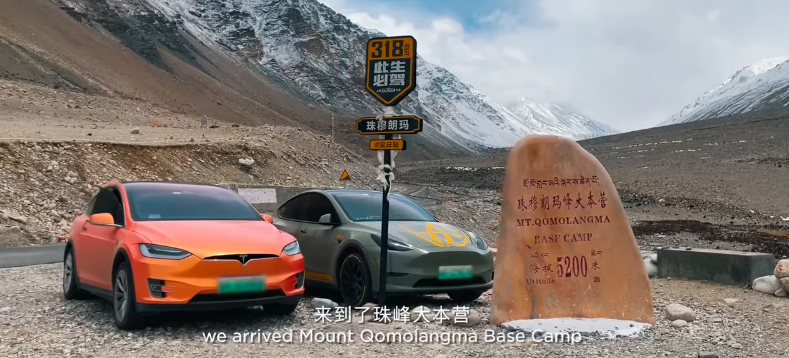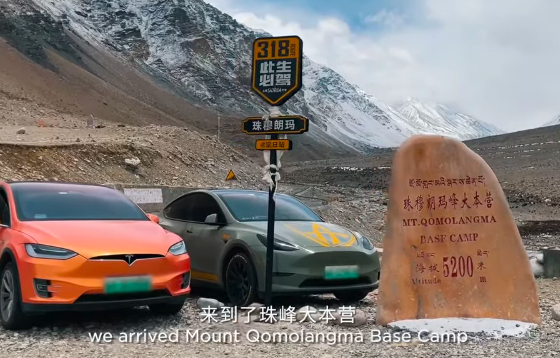

News
Tesla China shares incredible video of a journey to Mount Everest in 2 Teslas
Tesla China shared a video of a journey to Mount Qomolangma (Mount Everest) in made-in-China Tesla vehicles. Mount Everest is the tallest mountain on Earth.
Trensen Chongqing, China Bridge Designer Travel Vlogger was able to successfully undertake this incredible journey even when his friends and family told him that it was impossible.
The Qomolangma National Nature Reserve is located in Tibet, China and covers both the Chinese/Tibetan side of Mount Everest. Known to many as Mount Everest, it’s known to the Chinese as Qomolangma which means “Mother Goddess of the Earth” in the Tibetan language.
https://www.youtube.com/watch?v=Z_XO3chFvl0&t=4s
Getting To Mount Everest In An Electric Vehicle
“We just want to show only electric cars can get here.”
In the video titled, To Mount Qomolangma by Tesla, Trensen Chongqing, shared his adventure in a short video. The Tesla 318 Supercharging Route had recently been completed which thrilled him. He and his team set off on their adventure as soon as possible.
“But everyone thought I was losing my mind.”
Many naysayers told Chongqing that there was no way he could charge his car up there. It was too far. If it’s impossible for an internal combustible engine car, then surely it would be impossible for an EV. Someone even told him that there was no way he would make it and that they would buy him a month’s worth of hotpot if he made it.
Chongqing Accepted The Challenge.
“I love challenges.”
The journey itself is the most important part of the trip. It’s not about the destination at the end, but the experience along the way. The hardships, the people, and the learning opportunities. Chongqing noted that the whole point of a road trip is driving.
“There will be all kinds of unexpected issues. When they come, you have to figure out how to solve them.”
Landslides in the Jinsha River, traffic jams, and having to sleep in the car were all some of the challenges Chongqing and his team faced. Fortunately, Tesla has Camp Mode and they were able to do so safely.
The Plateau Is Harder On ICE Cars Than EV
Chongqing pointed out that the plateau is harder on ICE cars than EVs.
“On the plateaus, fuel cars may suffer from insufficient combustion but electric cars won’t. Once you put a foot down, wow. Feels like the whole world is yours.”
“Everything is fresh and unknown. These experiences will become your precious asset.”
Mount Everest Base Camp
This is not only an epic journey of adventurers but one that will be added to countless others that help debunk the common myth that you can’t go anywhere in an EV.
“Finally with two Teslas, we arrived at Mount Qomolangma Base Camp. Electric cars can do long road trips and even go further where ICE cars can not reach. Such as here, right beneath Mount Qomolangma.”
The video is inspiring and motivating. It makes one feel that nothing is really impossible–no matter how many people tell you that you will fail.

Elon Musk
Elon Musk and Tesla AI Director share insights after empty driver seat Robotaxi rides
The executives’ unoccupied tests hint at the rapid progress of Tesla’s unsupervised Robotaxi efforts.

Tesla CEO Elon Musk and AI Director Ashok Elluswamy celebrated Christmas Eve by sharing personal experiences with Robotaxi vehicles that had no safety monitor or occupant in the driver’s seat. Musk described the system’s “perfect driving” around Austin, while Elluswamy posted video from the back seat, calling it “an amazing experience.”
The executives’ unoccupied tests hint at the rapid progress of Tesla’s unsupervised Robotaxi efforts.
Elon and Ashok’s firsthand Robotaxi insights
Prior to Musk and the Tesla AI Director’s posts, sightings of unmanned Teslas navigating public roads were widely shared on social media. One such vehicle was spotted in Austin, Texas, which Elon Musk acknowleged by stating that “Testing is underway with no occupants in the car.”
Based on his Christmas Eve post, Musk seemed to have tested an unmanned Tesla himself. “A Tesla with no safety monitor in the car and me sitting in the passenger seat took me all around Austin on Sunday with perfect driving,” Musk wrote in his post.
Elluswamy responded with a 2-minute video showing himself in the rear of an unmanned Tesla. The video featured the vehicle’s empty front seats, as well as its smooth handling through real-world traffic. He captioned his video with the words, “It’s an amazing experience!”
Towards Unsupervised operations
During an xAI Hackathon earlier this month, Elon Musk mentioned that Tesla owed be removing Safety Monitors from its Robotaxis in Austin in just three weeks. “Unsupervised is pretty much solved at this point. So there will be Tesla Robotaxis operating in Austin with no one in them. Not even anyone in the passenger seat in about three weeks,” he said. Musk echoed similar estimates at the 2025 Annual Shareholder Meeting and the Q3 2025 earnings call.
Considering the insights that were posted Musk and Elluswamy, it does appear that Tesla is working hard towards operating its Robotaxis with no safety monitors. This is quite impressive considering that the service was launched just earlier this year.
Elon Musk
Starlink passes 9 million active customers just weeks after hitting 8 million
The milestone highlights the accelerating growth of Starlink, which has now been adding over 20,000 new users per day.

SpaceX’s Starlink satellite internet service has continued its rapid global expansion, surpassing 9 million active customers just weeks after crossing the 8 million mark.
The milestone highlights the accelerating growth of Starlink, which has now been adding over 20,000 new users per day.
9 million customers
In a post on X, SpaceX stated that Starlink now serves over 9 million active users across 155 countries, territories, and markets. The company reached 8 million customers in early November, meaning it added roughly 1 million subscribers in under seven weeks, or about 21,275 new users on average per day.
“Starlink is connecting more than 9M active customers with high-speed internet across 155 countries, territories, and many other markets,” Starlink wrote in a post on its official X account. SpaceX President Gwynne Shotwell also celebrated the milestone on X. “A huge thank you to all of our customers and congrats to the Starlink team for such an incredible product,” she wrote.
That growth rate reflects both rising demand for broadband in underserved regions and Starlink’s expanding satellite constellation, which now includes more than 9,000 low-Earth-orbit satellites designed to deliver high-speed, low-latency internet worldwide.
Starlink’s momentum
Starlink’s momentum has been building up. SpaceX reported 4.6 million Starlink customers in December 2024, followed by 7 million by August 2025, and 8 million customers in November. Independent data also suggests Starlink usage is rising sharply, with Cloudflare reporting that global web traffic from Starlink users more than doubled in 2025, as noted in an Insider report.
Starlink’s momentum is increasingly tied to SpaceX’s broader financial outlook. Elon Musk has said the satellite network is “by far” the company’s largest revenue driver, and reports suggest SpaceX may be positioning itself for an initial public offering as soon as next year, with valuations estimated as high as $1.5 trillion. Musk has also suggested in the past that Starlink could have its own IPO in the future.
News
NVIDIA Director of Robotics: Tesla FSD v14 is the first AI to pass the “Physical Turing Test”
After testing FSD v14, Fan stated that his experience with FSD felt magical at first, but it soon started to feel like a routine.

NVIDIA Director of Robotics Jim Fan has praised Tesla’s Full Self-Driving (Supervised) v14 as the first AI to pass what he described as a “Physical Turing Test.”
After testing FSD v14, Fan stated that his experience with FSD felt magical at first, but it soon started to feel like a routine. And just like smartphones today, removing it now would “actively hurt.”
Jim Fan’s hands-on FSD v14 impressions
Fan, a leading researcher in embodied AI who is currently solving Physical AI at NVIDIA and spearheading the company’s Project GR00T initiative, noted that he actually was late to the Tesla game. He was, however, one of the first to try out FSD v14.
“I was very late to own a Tesla but among the earliest to try out FSD v14. It’s perhaps the first time I experience an AI that passes the Physical Turing Test: after a long day at work, you press a button, lay back, and couldn’t tell if a neural net or a human drove you home,” Fan wrote in a post on X.
Fan added: “Despite knowing exactly how robot learning works, I still find it magical watching the steering wheel turn by itself. First it feels surreal, next it becomes routine. Then, like the smartphone, taking it away actively hurts. This is how humanity gets rewired and glued to god-like technologies.”
The Physical Turing Test
The original Turing Test was conceived by Alan Turing in 1950, and it was aimed at determining if a machine could exhibit behavior that is equivalent to or indistinguishable from a human. By focusing on text-based conversations, the original Turing Test set a high bar for natural language processing and machine learning.
This test has been passed by today’s large language models. However, the capability to converse in a humanlike manner is a completely different challenge from performing real-world problem-solving or physical interactions. Thus, Fan introduced the Physical Turing Test, which challenges AI systems to demonstrate intelligence through physical actions.
Based on Fan’s comments, Tesla has demonstrated these intelligent physical actions with FSD v14. Elon Musk agreed with the NVIDIA executive, stating in a post on X that with FSD v14, “you can sense the sentience maturing.” Musk also praised Tesla AI, calling it the best “real-world AI” today.








